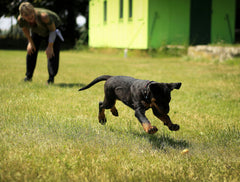
If anyone out there has any routine, it's walking their dog. It is something we can't miss or postpone. You can't ignore nature's calling and prevent your pup from having a little fun and exercise.
There are times when, however, it becomes too much and silly. For example, should you walk your dog ten times a day like a friend of mine? Or for 2 hours straight?
Many of us wonder what the ideal walk duration is and how often we should do it. Of course, the answer depends on your dog's health, size, and breed. So let me break it down below.
Benefits of walking your dog
I want to highlight that owning a dog is healthy for you in so many different ways. You are correct to say that owning a dog supports your mental health. It also supports the following:
- Cardiovascular health. People who walk daily tend to be less prone to cardiovascular accidents. Walking for at least 30 minutes a day could reduce your coronary heart disease risk by 19%.
- Lowers blood pressure. Research suggests that walking 30 minutes a day helps reduce your blood pressure just as much as any other medication could.
- Strengthens your muscles and bones. Walking every day will increase your bone density.
- Decreases stress. As little as 10 minutes of walking can help change your mood and lower your stress levels.
Every link I included above mentions a scientific study.
The health benefits also carry over to your dog. Keeping your dog active is one of the ways to prevent obesity, which itself correlates with several health risks:
- Osteoarthritis
- Cardiovascular disease
- Liver disease
- Insulin resistance
How long should you walk your dog?
The general rule that you will hear about how long you should walk your dog is between 30 minutes and 2 hours daily. However, remember that it could be 30 minutes once a day or 2x 1-hour walks.
The actual duration will depend on your dog's age, health, and size.
If you have a puppy
Puppies are small, young, and love to play! Since they are smaller, and their energy tends to run out quickly, you will want to stick to a 5-minute walk for every month of age until they're fully grown, up to twice a day.
For example, if your puppy is three months old, that would be a 15-minute walk, which you can repeat twice a day.
Walking your puppy is an excellent opportunity to train your puppy to come back to you when you call their name.
If you have a younger dog
Long walks are great for younger dogs, and they will need to get that pent-up energy out to be calmer at home.
One way to know if your dog is tired and needs to go home is to watch their breathing.
If you notice their breathing is heavy or slowing down, it's time for a water break and to head home.
If you have an older dog
If your dog is older or has arthritis, you may want to keep the walks shorter. However, to still get plenty of exercise in the day and at least 30 minutes total, you can complete several short walks or quick 10-minute games.
How long to walk your dog based on their breed
The advice above applies to most dogs, paired with your best judgment. I will also include below how long you should walk your dog based on some popular breeds.
Small dog breeds
Here is how long you should walk small-breed dogs:
- Chihuahua: 30 minutes.
- Boston Terrier: 30 minutes - 1 hour.
- Pug: 30 minutes - 1 hour.
- Yorkshire Terrier: 30 minutes.
- Shih Tzu: 30 minutes - 1 hour.
Medium-sized dog breeds
Here is how long you should walk medium-sized dogs:
- Bulldog: 30 minutes - 1 hour.
- Basset Hound: 30 minutes - 1 hour.
- Border Collie: 2 hours or more.
- Poodle: 30 minutes - 1 hour.
- American Foxhound: 2 hours or more.
Large dog breeds
Here is how long you should walk large-breed dogs:
- Labrador Retriever: 2 hours or more.
- Australian Shepherd: 2 hours or more.
- Bernese Mountain Dog: 30 minutes - 1 hour.
- Rottweiler: 2 hours or more.
- Great Dane: 2 hours or more.
My formula to know how long to walk your dog
I know not all the breeds are listed above, and you may still wonder how long to walk your dog. However, I still want you to use your best judgment, watch your dog's breathing, and consider any health condition.
Here is how long you should walk your dog based on their weight:
- Small dogs (<10lb): 30 minutes a day. You can break that into two 15-minute walks.
- Medium-sized dogs (10-50 lb): up to 1 hour a day, and at least 30 minutes.
- Large dogs (50+ lbs): about 2 hours a day. You can break this up into several walks.
If you enjoyed reading this article and would like to know when we publish similar ones, sign up for my newsletter below.




